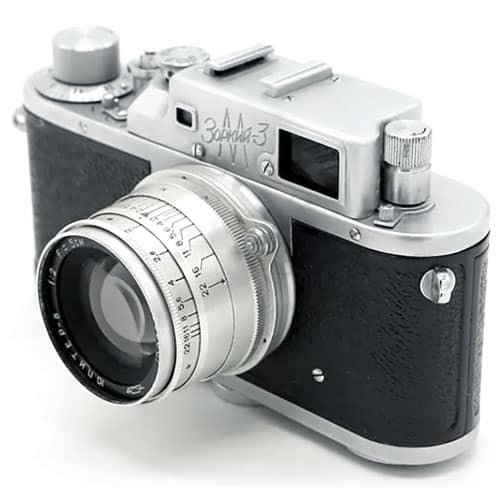Smena 4
In 1958, the production of the Smena 4 camera began, which is an improved Smena 3 with a self-timer and flash sync.

In the late 50s, GOMZ decided to improve the popular Smena 2 camera and created Smena 4. Along with this camera, a more simplified version called Smena 3 was simultaneously released.
Smena-4 Specifications
- Type: 35mm viewfinder camera
- Manufacturer: GOMZ plant
- Production period: from 1958 to 1960
- Format: 24x36cm on 135 film
- Lens mount: fixed lens
- Lens: T-22 f4.0/40
- Shutter: leaf shutter with speeds from 1/10 to 1/200 sec.
- Viewfinder: optical viewfinder
- Lighmeter: none
- Flash synchronisation: sync socket “X”,
- Selftimer: mechanical
- Weight: 290 grams
Nevertheless, according to the good old Soviet tradition, Smena 4 was not much different from all other models. The main innovations were that the camera finally got a normal shutter button. In addition, the shutter button on Smena 4 releases the shutter and unlocks the film advancing.

Smena 4 differed from earlier cameras of this family by the presence of a cocking lever, which significantly accelerated the photographing process. But this lever was on the left side, which is actually very unusual.
In fact, Smena 4 in some details and features was more advanced than the much later Smena 8m. But that’s the essence of the Soviet Union.


But if you often visit Sovietcameras.org, you most likely know how the desire of Soviet engineers to create something “modern and technologically complex” ends. Yes, the camera ended up being unreliable, and two years later it was discontinued.

As mentioned above, Smena 4 was almost no different from older models. It was also made of bakelite, and in the same way, was equipped with a non-replaceable Triplet T-22 4.5/40 lens.
In addition, the camera was equipped with a traditional leaf shutter with shutter speeds of 1/10, 1/25, 1/50, 1/100, 1/200, and B. The lever cocking of the shutter is not connected with the film advancing.


As you know, in the Soviet Union there were big problems with high-quality and technologically advanced cameras. But there have never been problems with super simple and elementary cameras for beginners.
And interestingly, the closer to the collapse of the Soviet Union, the worse cameras and other technologies became. Smena 8, produced up to the 90s practically does not differ for the better from the very first Smenas, released in the 50s.
Nevertheless, this soviet camera is an excellent example of the Soviet industry. It is cheap and simple, but it does its job.
SMENA 4 PHOTOS












